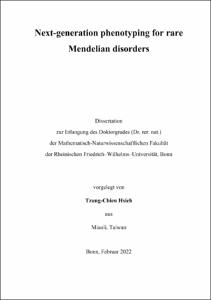Hsieh, Tzung-Chien: Next-generation phenotyping for rare Mendelian disorders. - Bonn, 2022. - Dissertation, Rheinische Friedrich-Wilhelms-Universität Bonn.
Online-Ausgabe in bonndoc: https://nbn-resolving.org/urn:nbn:de:hbz:5-67525
Online-Ausgabe in bonndoc: https://nbn-resolving.org/urn:nbn:de:hbz:5-67525
@phdthesis{handle:20.500.11811/10206,
urn: https://nbn-resolving.org/urn:nbn:de:hbz:5-67525,
author = {{Tzung-Chien Hsieh}},
title = {Next-generation phenotyping for rare Mendelian disorders},
school = {Rheinische Friedrich-Wilhelms-Universität Bonn},
year = 2022,
month = aug,
note = {Worldwide, rare genetic disorders affect more than 6.2% of the population. The long diagnostic process is often called the ‘diagnostic odyssey.’ With the recent advances in computer vision, many next-generation phenotyping (NGP) approaches such as DeepGestalt have shown a strong ability to differentiate rare disorders and are widely used by clinicians in clinics. However, the current NGP approaches for rare disorders still have limitations on three aspects: current approaches do not support ultra-rare and novel disorders; no publicly available dataset; lack of automatic diagnostic pipeline that integrates exome and facial analysis. Therefore, we proposed GestaltMatcher, GestaltMatcher Database (GMDB), and Prioritization of Exome Data by Image Analysis (PEDIA) to tackle the current difficulties.
We first developed GestaltMatcher as an extension to DeepGestalt to support ultra-rare and novel disorders. GestaltMatcher first encoded the frontal image into a 320-dimensional Facial Phenotype Descriptor (FDP). We further formed a Clinical Face Phenotype Space by the FDPs and quantified the facial syndromic similarities among the patients by calculating the cosine distance between two FDPs in the space. This approach can support ultra-rare disorders and novel diseases and analyze the patients’ similarities to explore the novel gene-phenotype relationship.
To solve the problem of lacking a public medical image dataset, we proposed GMDB to host the medical images curated from the publication and the consented patients. GMDB is an open-access medical image database to the research community for deep learning purposes and reference material for clinician-scientists to easily see the medical images.
In order to support the facial phenotyping approach in the automatic exome diagnosis, the PEDIA approach was proposed to integrate facial analysis into the exome prioritization pipeline. We further showed GeneTalk platform as an example of implementing the PEDIA approach into an existed variant analysis platform.
In the end, we envision that GestaltMatcher, GMDB, and PEDIA can be integrated into a diagnostic platform and further connected with the patient match platforms such as MatchMaker Exchange to enable global collaboration and further improve the diagnosis of rare Mendelian disorders.},
url = {https://hdl.handle.net/20.500.11811/10206}
}
urn: https://nbn-resolving.org/urn:nbn:de:hbz:5-67525,
author = {{Tzung-Chien Hsieh}},
title = {Next-generation phenotyping for rare Mendelian disorders},
school = {Rheinische Friedrich-Wilhelms-Universität Bonn},
year = 2022,
month = aug,
note = {Worldwide, rare genetic disorders affect more than 6.2% of the population. The long diagnostic process is often called the ‘diagnostic odyssey.’ With the recent advances in computer vision, many next-generation phenotyping (NGP) approaches such as DeepGestalt have shown a strong ability to differentiate rare disorders and are widely used by clinicians in clinics. However, the current NGP approaches for rare disorders still have limitations on three aspects: current approaches do not support ultra-rare and novel disorders; no publicly available dataset; lack of automatic diagnostic pipeline that integrates exome and facial analysis. Therefore, we proposed GestaltMatcher, GestaltMatcher Database (GMDB), and Prioritization of Exome Data by Image Analysis (PEDIA) to tackle the current difficulties.
We first developed GestaltMatcher as an extension to DeepGestalt to support ultra-rare and novel disorders. GestaltMatcher first encoded the frontal image into a 320-dimensional Facial Phenotype Descriptor (FDP). We further formed a Clinical Face Phenotype Space by the FDPs and quantified the facial syndromic similarities among the patients by calculating the cosine distance between two FDPs in the space. This approach can support ultra-rare disorders and novel diseases and analyze the patients’ similarities to explore the novel gene-phenotype relationship.
To solve the problem of lacking a public medical image dataset, we proposed GMDB to host the medical images curated from the publication and the consented patients. GMDB is an open-access medical image database to the research community for deep learning purposes and reference material for clinician-scientists to easily see the medical images.
In order to support the facial phenotyping approach in the automatic exome diagnosis, the PEDIA approach was proposed to integrate facial analysis into the exome prioritization pipeline. We further showed GeneTalk platform as an example of implementing the PEDIA approach into an existed variant analysis platform.
In the end, we envision that GestaltMatcher, GMDB, and PEDIA can be integrated into a diagnostic platform and further connected with the patient match platforms such as MatchMaker Exchange to enable global collaboration and further improve the diagnosis of rare Mendelian disorders.},
url = {https://hdl.handle.net/20.500.11811/10206}
}






